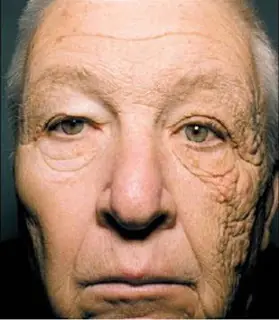The husband stands near the window with the child and says that the baby gets vitamin D3 through the window. Is he right?

I'll start with the thesis of the previous speaker
There are 3 types of ultraviolet radiation
- UVC (UVC) is mostly neutralized by the earth's atmosphere. Therefore, the ozone hole at one time seriously alarmed the world community. Our body is in no way adapted to survive under UVC rays.

UVB-rays (UVB) were felt by everyone who has ever been burned on the beach. They are what most people think of, calling creams with sun filters “beach” and buying them only in the summer for vacation.
UVA-radiation (UVA) penetrates deep into the middle layer of the skin, destroying it from the inside, which becomes noticeable in wrinkles. Creams with filters against UVA rays are the only effective remedy against visible skin aging and the only type of cosmetic products that affect the condition of the dermis. All others are effective only within the epidermis. Don't waste your money on creams with collagen and elastin. These substances are located in the dermis; only clothing or a UVA filter can protect them, so it makes no sense to spread someone’s collagen and elastin on top. It will not penetrate inside and replace its own.
About glass and radiation
The windshield in cars, which is a complex multilayer structure, protects the skin only from UVB radiation. That is, it is difficult to tan under it (tanning is a milder form of skin burn, there is nothing “healthy” about it), but it does not stop UVA in any way. Your child is behind ordinary glass. It stops any radiation to an even lesser extent. Look what happened to an American truck driver, 69 years old, who spent 28 of those years behind the wheel. The part of the face that looks especially bad was next to the open side window and was exposed to full radiation without any barrier. This photo is from medical journal:

UVA rays pass through window glass, penetrating the epidermis and upper layers of the dermis. Constant (in the text - “chronic”) stay under them leads to thinning of the epidermis and stratum corneum (that is, the upper layer of the epidermis, consisting of dead cells) along with the destruction of elastic fibers.
Conclusions?
Your husband is right about only one thing: the child receives radiation, under the influence of which the liver produces vitamin D3. At the same time he receives more harm than good, because the vitamin is formed in negligible quantities, and the skin is destroyed in significant quantities. Just standing by the window does not replace playing in the fresh air and taking vitamin D3 drops if the child does not have enough of it.

There were times when tanned skin was considered a sign of low birth, and noble ladies tried to protect their faces and hands from the sun's rays in order to maintain their aristocratic pallor. Later, the attitude towards tanning changed - it became an indispensable attribute of a healthy and successful person. Today, despite the ongoing controversy regarding the benefits and harms of sun exposure, bronze skin tone is still at the peak of popularity. But not everyone has the opportunity to visit the beach or solarium, and in this regard, many are interested in whether it is possible to sunbathe through window glass, sitting, for example, on a sun-warmed glazed loggia or attic.
Probably every professional driver or just a person who spends a long time behind the wheel of a car has noticed that his hands and face become lightly tanned over time. The same applies to office workers who are forced to sit at an uncurtained window for the entire work shift. You can often find traces of tanning on their faces even in winter. And if a person is not a regular at solariums and does not take a daily promenade through parks, then this phenomenon cannot be explained otherwise than by tanning through glass. So does glass allow ultraviolet light to pass through and is it possible to tan through the window? Let's figure it out.
The nature of tanning
In order to answer the question of whether it is possible to get a tan through ordinary window glass in a car or on a loggia, you need to understand exactly how the process of darkening the skin occurs and what factors influence it. First of all, it should be noted that tanning is nothing more than a protective reaction of the skin to solar radiation. Under the influence of ultraviolet light, epidermal cells (melanocytes) begin to produce the substance melanin (dark pigment), due to which the skin acquires a bronze tint. The higher the concentration of melanin in the upper layers of the dermis, the more intense the tan. However, not all UV rays cause such a reaction, but only those lying in a very narrow range of wavelengths. Ultraviolet rays are divided into three types:
- A-rays (long wave) — are practically not retained by the atmosphere and reach the earth’s surface without hindrance. Such radiation is considered the safest for the human body, since it does not activate melanin synthesis. All it can do is cause slight darkening of the skin, and then only with prolonged exposure. However, with excessive insolation by long-wave rays, collagen fibers are destroyed and the skin is dehydrated, as a result of which it begins to age faster. And some people develop an allergy to the sun precisely because of A-rays. Long-wave radiation easily overcomes the thickness of window glass and leads to gradual fading of wallpaper, furniture surfaces and carpets, but it is impossible to obtain a full tan with its help.
- B-rays (medium wave) - linger in the atmosphere and only partially reach the Earth's surface. This type of radiation has a direct effect on the synthesis of melanin in skin cells and contributes to the appearance of a quick tan. And with its intense impact on the skin, burns of varying degrees occur. B-rays cannot penetrate through ordinary window glass.
- C-rays (short wave) - pose a huge danger to all living organisms, but, fortunately, they are almost completely neutralized by the atmosphere without reaching the Earth’s surface. You can only encounter such radiation high in the mountains, but even there its effect is extremely weakened.
Physicists identify another type of ultraviolet radiation - extreme, for which the term “vacuum” is often used due to the fact that waves in this range are completely absorbed by the Earth’s atmosphere and do not reach the earth’s surface.
Can you tan through glass?
Whether you can get a tan through window glass or not directly depends on what properties it has. The fact is that there are different types of glass, each of which is affected differently by UV rays. Thus, organic glass has a high transmission capacity, which allows the passage of the entire spectrum of solar radiation. The same applies to quartz glass, which is used in solarium lamps and in devices for disinfecting rooms. Ordinary glass, used in residential premises and cars, transmits only long-wavelength rays of type A, and it is impossible to get sunburned through it. It's another matter if you replace it with plexiglass. Then you can sunbathe and enjoy a beautiful tan almost all year round.
Although sometimes there are cases when a person spends some time under the sun's rays passing through a window, and then discovers a light tan on open areas of the skin. Of course, he is fully confident that he got tanned precisely by insolation through the glass. But it is not so. There is a very simple explanation for this phenomenon: the change in shade in this case occurs as a result of the activation of a small amount of residual pigment (melanin) produced under the influence of ultraviolet type B, located in skin cells. As a rule, such a “tan” is temporary, that is, it quickly disappears. In a word, in order to get a full-fledged tan, you need to either visit a solarium or regularly take sunbathing, and it will not be possible to change the natural skin tone towards a darker one through ordinary window or car glass.
Do you need to defend yourself?
Only those people who have very sensitive skin and a predisposition to age spots should worry about whether it is possible to get a tan through glass. They are recommended to constantly use special products with a minimum degree of protection (SPF). Such cosmetics should be applied mainly to the face, neck and décolleté. However, you shouldn’t protect yourself too actively from ultraviolet radiation, especially long-wave radiation, because the sun’s rays in moderation are very useful and even necessary for the normal functioning of the human body.

Ultraviolet
Solar radiation causes a darkening of the human skin, which is called tanning. It is generally accepted that if sunlight falls through transparent objects, then all its rays fully reach the surface of the skin, so tanning can also occur in this case. But in reality this is not so: a person practically does not sunbathe through glass. This is explained by the fact that glass blocks part of the radiation, which is responsible for the production of melanin in the human body.
Ultraviolet radiation is divided into three types: A, B and C. The first is long-wave: these waves act unnoticed, penetrating the skin and affecting various internal processes. These rays reduce the amount of water, collagen and elastin in the epidermal cells, causing the skin to age faster. Long-wave radiation can cause an allergic reaction and slight redness, but does not contribute to the appearance of a tan, since melanin does not appear in the cells. Under its influence, only precursors of this substance are formed - elements without color, which only when oxidized can cause darkening of the skin.
Short-wavelength B radiation causes human melanocytes to produce melanin, resulting in darker skin. If the dose of this radiation is high, a burn may occur, and with regular exposure to large amounts of type B rays, skin cancer appears.
C rays almost never reach the Earth's surface, being absorbed by the ozone layer.
Tanning through glass
Glass transmits only long-wave radiation, and blocks B rays, so the production of melanin under the influence of sunlight behind the glass is impossible. But long waves of type A do not lose their ability to influence human skin: they not only cause aging, but also prepare the skin for exposure to rays B. With prolonged exposure to the rays of the sun penetrating through glass, a slight redness is possible, but no more: melanocytes do not work in this case. It is theoretically possible to tan through glass if you are constantly exposed to radiation. But this is not a tan in the truest sense of the word: it is heat damage to the skin that leads to redness.
It is the constant action of long-wave radiation that can explain why the hands of car drivers on the window side darken after long trips.
All of the above applies to ordinary window glass; other types - quartz or plexiglass - transmit ultraviolet rays much better, and they are used for solariums.





